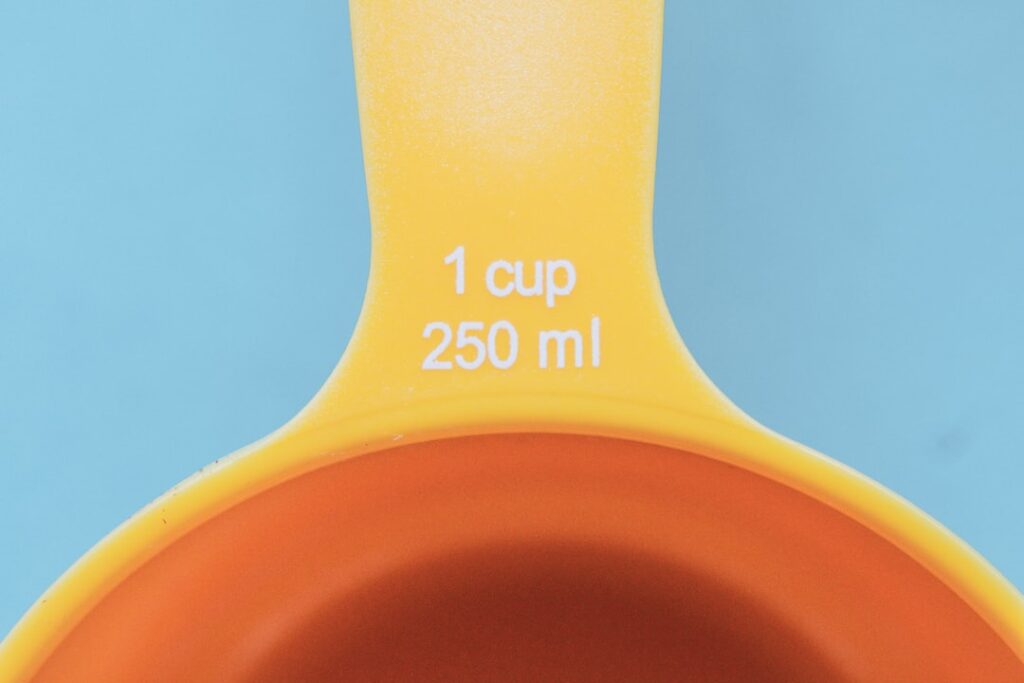Why Understanding Ounces per Gallon Matters for Every Kitchen
Ounces per gallon conversions pop up everywhere – from scaling recipes for dinner parties to mixing cleaning solutions and tracking daily hydration goals. Whether you’re a seasoned chef or weekend cook, mastering this simple conversion saves time and prevents costly mistakes.
Quick Answer:
- US Gallon: 128 fluid ounces
- Imperial (UK) Gallon: 160 fluid ounces
- US Dry Gallon: 148.945 ounces (rarely used)
- Half Gallon: 64 fl oz (US) or 80 fl oz (UK)
- Quarter Gallon: 32 fl oz (US) or 40 fl oz (UK)
Have you ever found yourself mid-recipe, staring at measurements that don’t match your containers? You’re not alone. As one food blogger noted: “How many oz in a gallon?” is probably something you’ve Googled after reading a recipe asking for 32 oz of milk or water.
The confusion stems from different measurement systems. The US uses 128 fluid ounces per gallon, while the UK uses 160 fluid ounces per gallon. Dry gallons exist too, but they’re rarely used in modern cooking.
Understanding these conversions becomes crucial when you’re:
- Doubling recipes for larger gatherings
- Converting between metric and imperial measurements
- Mixing concentrates for cleaning or gardening
- Planning hydration for travel days
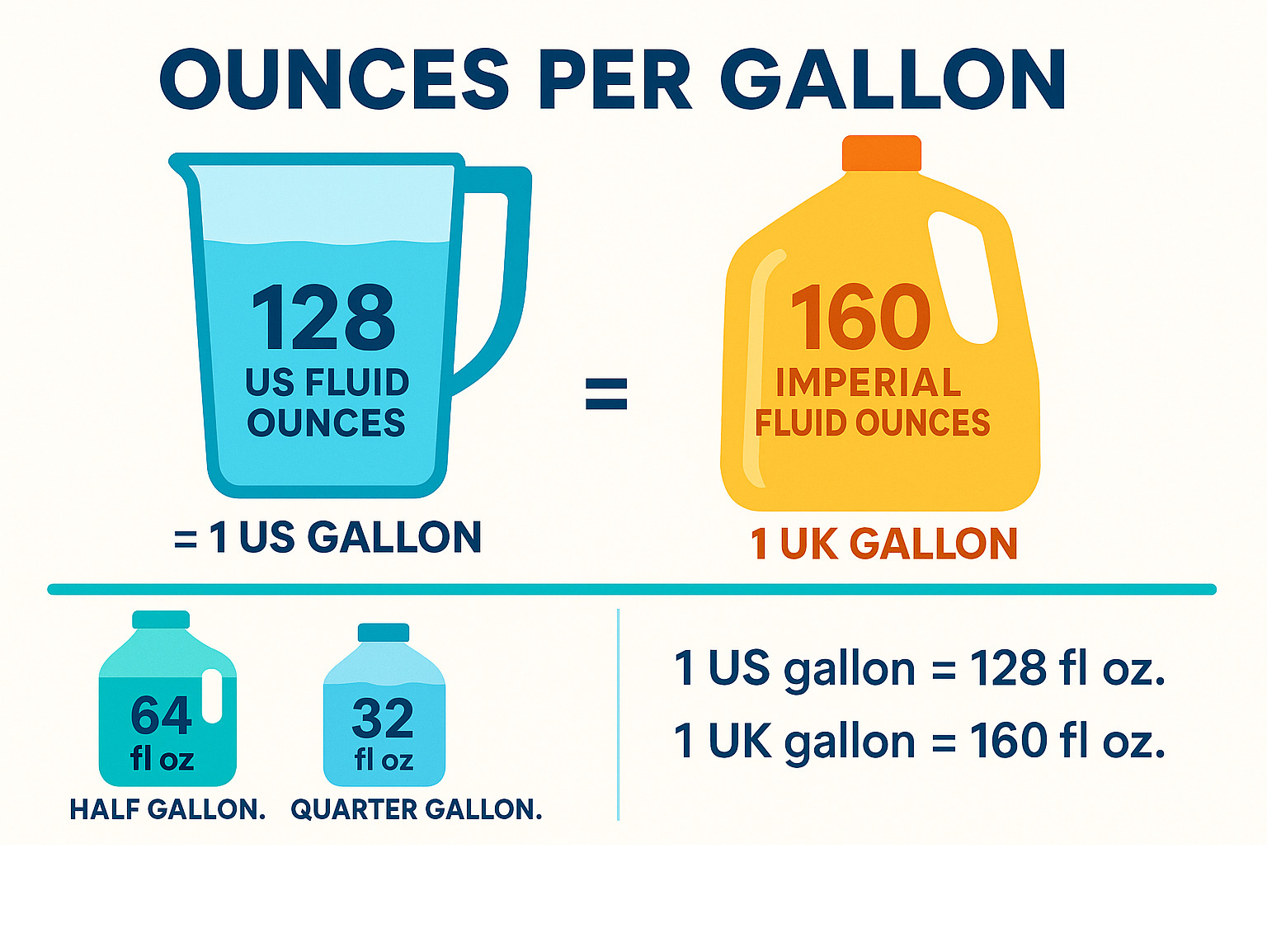
The Basics: Gallon & Ounce Definitions
Ever wonder why ounces per gallon conversions feel so confusing? The answer lies in centuries of history and different measurement systems that somehow all survived into our modern kitchens.
Let’s start with where these words even came from. “Gallon” traces back to medieval Latin “galleta” or the Celtic word “galla” – both referring to wine vessels. Pretty fitting, considering how often we still use gallons for liquids today! Meanwhile, “ounce” comes from the Roman “uncia,” which originally meant a twelfth of a copper bar. Those Romans really knew how to complicate things.
Today’s cooking world gives us three different types of gallons to work with, though you’ll mostly encounter just one or two.
The wet gallon (also called liquid gallon) is your kitchen workhorse. This is what you use for water, milk, cooking oils, and any other liquid ingredient. In the US Customary system, one wet gallon equals exactly 128 fluid ounces. But here’s where it gets interesting – if you’re following a recipe from across the pond, the Imperial system uses 160 fluid ounces per gallon.
Then there’s the dry gallon, defined as 1/8 of a bushel or 231 cubic inches. This equals approximately 148.945 ounces. But honestly? You’ll probably never need this one. Most recipes stick to liquid measurements, and dry ingredients are usually measured by weight instead of volume.
| System | Volume | Fluid Ounces | Liters |
|---|---|---|---|
| US Gallon | 128 fl oz | 128 | 3.785 L |
| Imperial Gallon | 160 fl oz | 160 | 4.546 L |
| US Dry Gallon | 148.945 oz | 148.945 | 4.405 L |
Why Two Gallons Exist
You might be wondering why we can’t just pick one gallon size and stick with it. Well, blame historical standardization – or the lack thereof.
The US gallon contains 128 fl oz and equals 3.785 litres, while the Imperial gallon holds 160 fl oz and equals 4.546 litres. That makes the Imperial gallon about 20% larger than its American cousin. So when you’re following a British recipe calling for a gallon of stock, you’re actually looking at 1.2 US gallons worth of liquid.
This difference in volume standards creates some important numbers to remember. The 128 fl oz vs 160 fl oz split means you need to know which system your recipe uses before you start measuring. Getting this wrong can seriously throw off your cooking ratios.
The litres equivalent provides a helpful bridge between systems. One US gallon equals approximately 3.785 litres, while one Imperial gallon equals about 4.546 litres. When in doubt, converting to metric first can help you double-check your math.
Fluid vs Dry Ounces
Here’s where many home cooks trip up, and honestly, it’s not your fault – the system is genuinely confusing.
Fluid ounces measure volume (think: how much space something takes up), while dry ounces measure weight (think: how heavy something is). This weight vs volume difference matters more than you might expect for recipe accuracy.
Picture this: you grab a pint container and fill it with blueberries. That container holds 16 fluid ounces of space, but those blueberries only weigh about 12 ounces. The berries don’t fill every tiny air pocket, creating this weight-versus-volume gap.
When we talk about ounces per gallon, we’re specifically discussing fluid ounces – volume measurements. This distinction becomes crucial in baking, where precision can make or break your results. The avoirdupois system (our standard weight measurement system) uses different ounces than fluid measurements, which explains why your kitchen scale and measuring cups sometimes seem to disagree.
For more technical details about measurement systems and their precision, you can explore this scientific research on measurement precision.
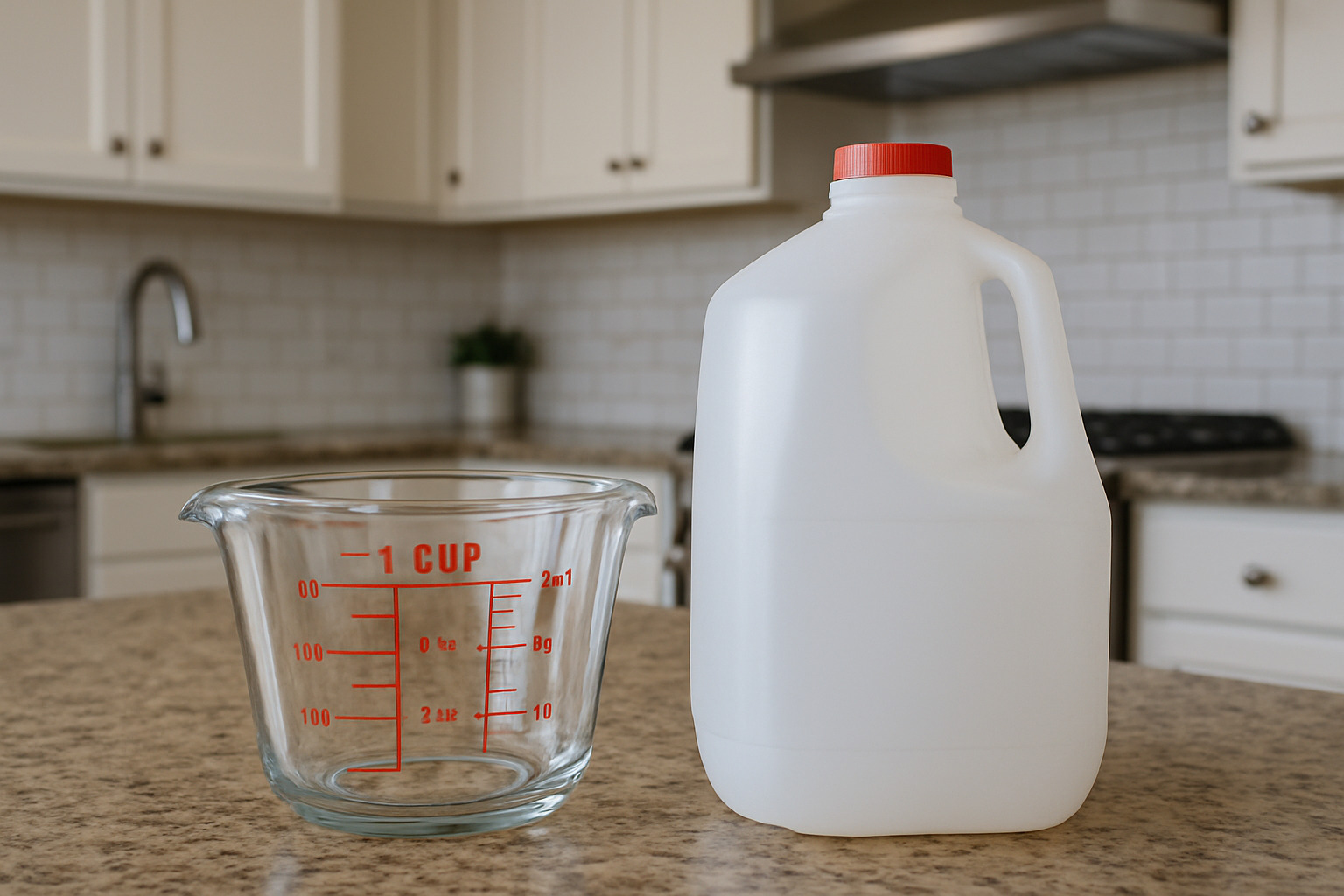
Quick Answer: Ounces per Gallon
Let’s cut to the chase with the numbers you need most often. Memorizing these basic ounces per gallon conversions will save you countless Google searches:
Mental Math Tricks:
- Think “128” for US gallons (12+8=20, easy to remember)
- Imperial gallons use “160” (16 × 10)
- Half everything for half-gallons
- Quarter everything for quarter-gallons
Ounces per Gallon in the US System
The US system uses these standard conversions:
- 1 gallon = 128 fluid ounces
- ½ gallon = 64 fluid ounces
- ¼ gallon = 32 fluid ounces
These numbers appear constantly in cooking. A standard milk jug holds a half-gallon (64 oz), while many large yogurt containers hold a quart or 32 oz. When you see “32 oz of milk” in a recipe, you know that’s exactly one quart or a quarter-gallon.
Ounces per Gallon in the Imperial System
The Imperial system, still used in the UK and some Commonwealth countries, works differently:
- 1 gallon = 160 fluid ounces
- ½ gallon = 80 fluid ounces
- ¼ gallon = 40 fluid ounces
This difference matters when following international recipes or traveling. That “pint of ale” in an English pub contains 20 fluid ounces, not the 16 ounces you’d expect from a US pint.
Conversion & Calculation Guide
Converting ounces per gallon becomes your kitchen superpower once you master a few simple formulas. Think of it like learning to ride a bike – awkward at first, but soon you’ll be doing these calculations without breaking a sweat.
The golden rules are refreshingly simple: For US conversions, divide fluid ounces by 128 to get gallons, or multiply gallons by 128 to get fluid ounces. For Imperial conversions, use 160 instead. That’s it – no complex math required.
The metric bridge makes international cooking much easier. 1 US fluid ounce equals approximately 29.57 mL, while 1 US gallon equals about 3.785 liters. Imperial measurements are slightly different, with 1 Imperial fluid ounce equaling about 28.41 mL and 1 Imperial gallon containing 4.546 liters.
When you’re juggling multiple kitchen conversions, our guide on How Many Tablespoons in a Cup? provides more essential measurements that work hand-in-hand with ounces per gallon calculations.
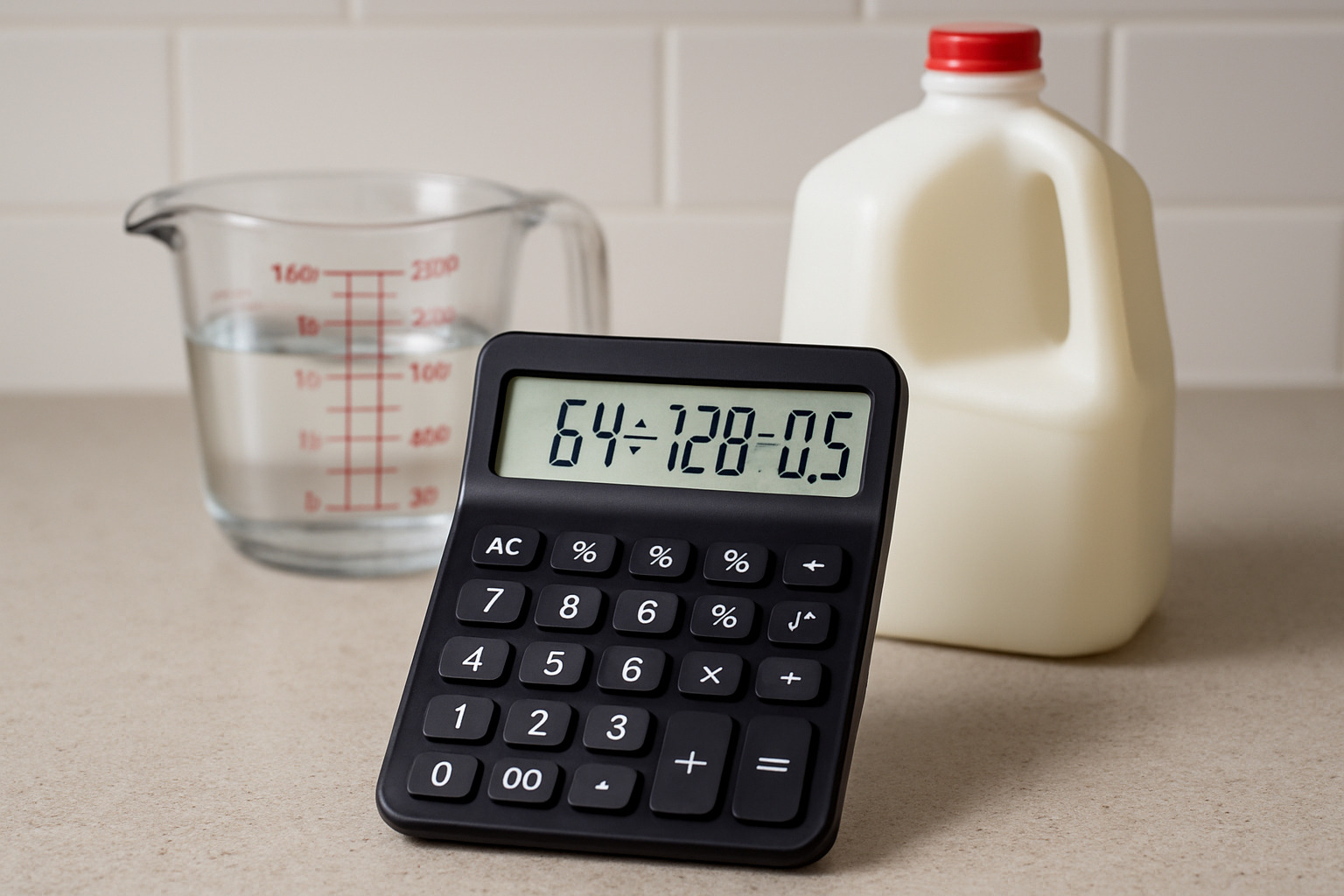
Step-by-Step Example
Let’s walk through some real-world scenarios you’ll actually encounter in your kitchen.
Converting 64 ounces to gallons: Take 64 oz and divide by 128, which gives you 0.5 gallons – exactly half a gallon. This is the size of those standard milk containers you grab from the grocery store.
Converting 3 gallons to UK fluid ounces: Multiply 3 gallons by 160 to get 480 Imperial fluid ounces. This matters when you’re following a British recipe or buying ingredients abroad.
Figuring out how many 16 oz bottles make a gallon: Divide 128 oz by 16 oz per bottle, and you get 8 bottles. Perfect for planning your daily hydration or stocking up for a camping trip.
These calculations become second nature faster than you’d expect. Keep a conversion chart stuck to your fridge until the numbers feel automatic.
Metric Shortcuts
Working between measurement systems doesn’t have to give you a headache. These shortcuts work beautifully for everyday cooking situations.
1 US gallon roughly equals 3.8 liters – close enough for most recipes where precision isn’t critical. When you see “4 liters of stock” in a European recipe, you know you need just over a gallon.
1 liter contains about 34 fluid ounces, which helps when you’re converting those sleek European ingredient measurements. And 250 mL equals roughly 1 cup, making it easy to adapt metric recipes to your familiar measuring cups.
For situations where precision matters most – like when you’re scaling commercial recipes or mixing cleaning concentrates – use a reliable online conversion tool to double-check your math.
Real-World Uses & Dilution Ratios
Understanding ounces per gallon becomes incredibly practical when you step beyond basic cooking measurements. Whether you’re hosting a dinner party, tackling spring cleaning, or planning your daily hydration, these conversions pop up in surprising places.
In the kitchen, ounces per gallon knowledge shines when you’re scaling recipes. That soup recipe for four suddenly needs to feed twenty guests? You’ll multiply ingredients by five, turning 32 ounces of broth into a full gallon plus extra. European recipes using liters become manageable too – just remember that 3.8 liters roughly equals one US gallon.
Cleaning concentrates present some of the most practical uses for dilution ratios. Many commercial cleaners specify mixing ratios like 1:32 or 1:64, which translates directly to ounces per gallon. For a 1:32 ratio, you’ll use 4 ounces per gallon (128 ÷ 32 = 4). A 1:64 ratio needs just 2 ounces per gallon (128 ÷ 64 = 2).
These ratios matter beyond just getting the mixture right. Understanding them helps you calculate the true cost of cleaning solutions. Take a $12.50 concentrate with a 1:64 ratio – divide $12.50 by 64 to get roughly $0.20 per ready-to-use gallon. That’s significant savings compared to buying pre-mixed cleaners.
Hydration tracking becomes simpler with gallon thinking too. Scientific research on hydration needs shows men need about 125 fluid ounces daily – that’s nearly a full gallon. Women need around 91 fluid ounces, or about three-quarters of a gallon. Suddenly, those gallon water bottles with hourly markers make perfect sense.
Garden applications use similar dilution principles. When mixing fertilizers or natural pest control solutions, you’ll often encounter these same ratios. For natural pest control methods, check out our guide on How to Get Rid of Fruit Flies which includes dilution ratios for effective home solutions.
Mixing Chart Highlights
The most common dilution ratios you’ll encounter follow predictable patterns. All-purpose cleaners typically use 4 ounces per gallon (1:32 ratio), while disinfectants often require just 2 ounces per gallon (1:64 ratio). Light cleaning solutions might use only 1 ounce per gallon (1:128 ratio).
Understanding these ratios helps with chemical safety too. Stronger concentrates mean less product per gallon, reducing exposure risks while maintaining effectiveness. Always read labels carefully and never guess at dilution ratios – the difference between 2 ounces and 4 ounces per gallon can mean the difference between effective cleaning and wasted product.
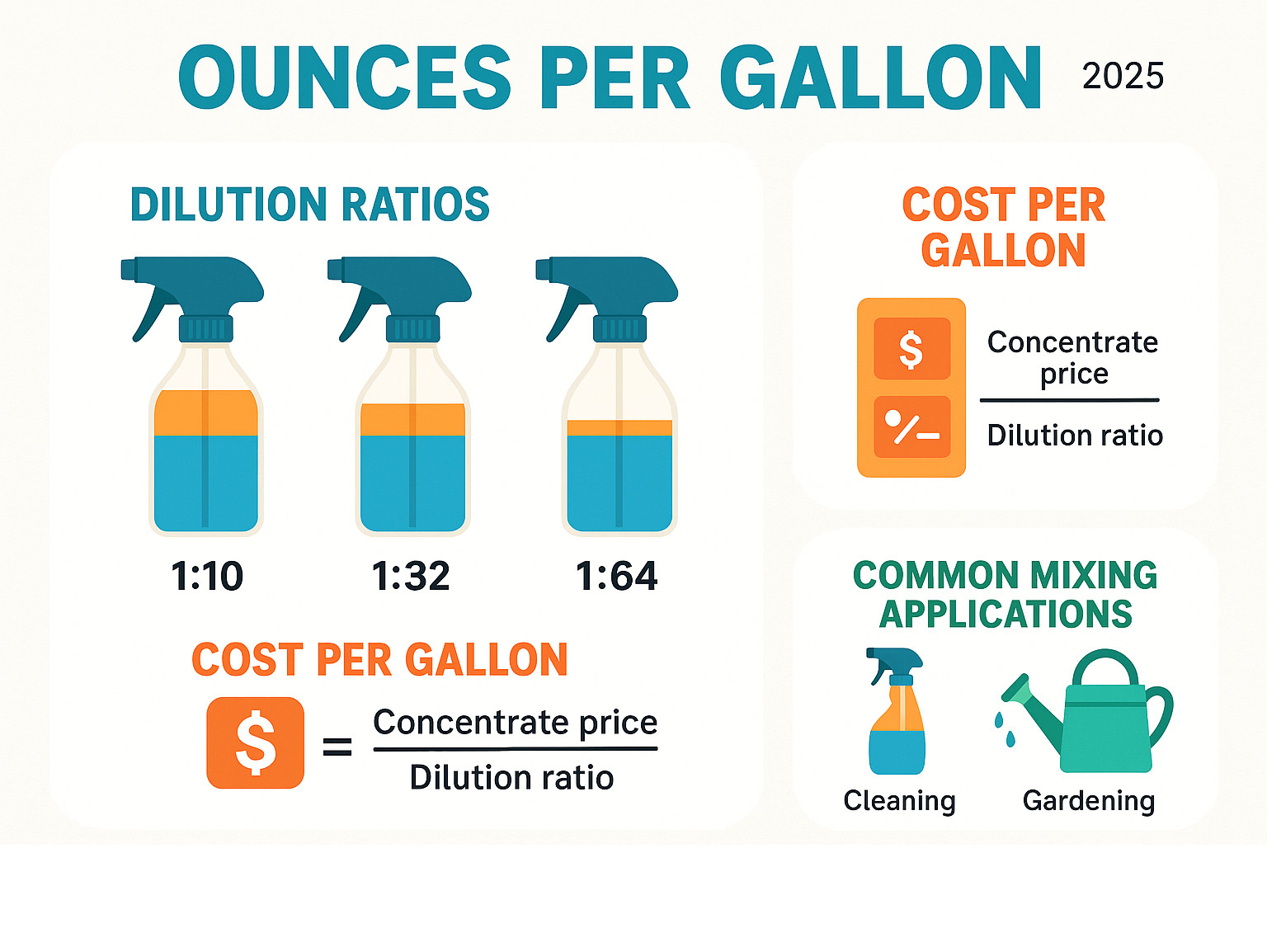
Common Mistakes & Troubleshooting
Even experienced cooks make ounces per gallon conversion errors. Here are the most common mistakes and how to avoid them:
Wet vs Dry Confusion:
The biggest error? Mixing up fluid ounces (volume) with dry ounces (weight). Remember: we measure liquids by volume, solids by weight. A cup of flour weighs about 4.5 ounces but occupies 8 fluid ounces of space.
Wrong System Assumptions:
Always check whether a recipe uses US or Imperial measurements. That “gallon of stock” in a British cookbook needs 160 fl oz, not 128 fl oz. The difference could ruin your dish’s consistency.
Rounding Errors:
While 1 US gallon ≈ 3.8 liters works for casual cooking, precision baking requires the exact 3.785 liters. Small errors compound when scaling recipes.
Density Oversights:
Different liquids have different densities. A gallon of water weighs about 8.34 pounds, but a gallon of honey weighs much more. When converting between weight and volume, density matters.
Temperature Effects:
Liquids expand and contract with temperature changes. Hot liquids measure differently than cold ones, though this rarely affects home cooking significantly.
Keep a Cheat Sheet Handy:
Until these conversions become automatic, keep a reference chart in your kitchen. Many experienced cooks still double-check their math for large batches.
Frequently Asked Questions about Ounces per Gallon
Is 64 ounces a gallon?
Not quite! 64 ounces equals half a gallon in the US system. A full US gallon contains 128 fluid ounces, making 64 ounces exactly half that amount.
This mix-up happens all the time because those popular large water bottles at the gym hold 64 ounces. People grab one thinking they’re drinking a full gallon, but they’re actually getting half their goal. If you’re trying to drink a gallon a day for hydration, you’ll need two of those big bottles.
The confusion makes sense – 64 ounces feels like a lot of water! But when you’re scaling recipes or mixing cleaning solutions, knowing that ounces per gallon calculation becomes crucial.
How many 16 oz bottles make a gallon?
Eight 16-ounce bottles equal one US gallon. The math is straightforward: 128 fluid ounces ÷ 16 fluid ounces = 8 bottles exactly.
This works for any 16-ounce container – water bottles, beer bottles, or those mason jars you use for meal prep. It’s actually a handy way to visualize a gallon when you’re planning drinks for a party or tracking your daily water intake.
Here’s where it gets interesting: if you’re working with Imperial measurements (like in the UK), you’d need 10 bottles to make a gallon since Imperial gallons contain 160 fluid ounces. Always check which system your recipe uses!
How do I convert gallons to liters quickly?
For quick kitchen conversions, multiply US gallons by 3.8 to get approximate liters. The exact conversion is 3.785, but 3.8 works perfectly for most cooking needs. Your soup won’t know the difference!
Going the other direction? Divide liters by 3.8 to get US gallons. So that 2-liter bottle of soda equals about half a gallon.
Imperial gallons are trickier – multiply by 4.5 (the exact number is 4.546). This bigger difference explains why following a British recipe can throw off your measurements if you’re not careful. When precision matters for baking or cocktail mixing, use the exact numbers or grab a reliable conversion calculator.
Conclusion
Mastering ounces per gallon conversions transforms how you approach cooking, cleaning, and even daily hydration. Whether you’re scaling your grandmother’s soup recipe for a dinner party or mixing the perfect cleaning solution, these numbers become your kitchen superpowers.
Think about it – no more standing in your kitchen, phone in hand, frantically googling “how many ounces in a gallon” while your sauce simmers on the stove. You’ll know that 128 fluid ounces equals 1 US gallon, that 160 fluid ounces fills an Imperial gallon, and that your trusty half-gallon milk jug holds exactly 64 fluid ounces.
These conversions open doors to culinary trips too. That intriguing British recipe calling for a gallon of stock? You’ll confidently measure 160 fluid ounces instead of the US standard 128. Planning a big batch of homemade kombucha? You’ll easily calculate how many bottles you need from your gallon of tea.
At The Dining Destination, we’ve seen how understanding measurements lifts every food journey. From calculating wine quantities for large gatherings to converting fascinating international recipes you find during your culinary explorations, these skills support your dining trips wherever they take you.
The beauty lies in the simplicity once you get it. Your brain starts automatically thinking “eight 16-ounce bottles make a gallon” or “that’s a 1:64 ratio, so I need 2 ounces per gallon.” What once seemed confusing becomes as natural as knowing a dozen equals twelve.
Keep this guide bookmarked for those moments when the math gets tricky. And remember – every professional chef started exactly where you are now, learning these fundamental conversions that make cooking feel effortless. Your future self will thank you for mastering these basics today.

